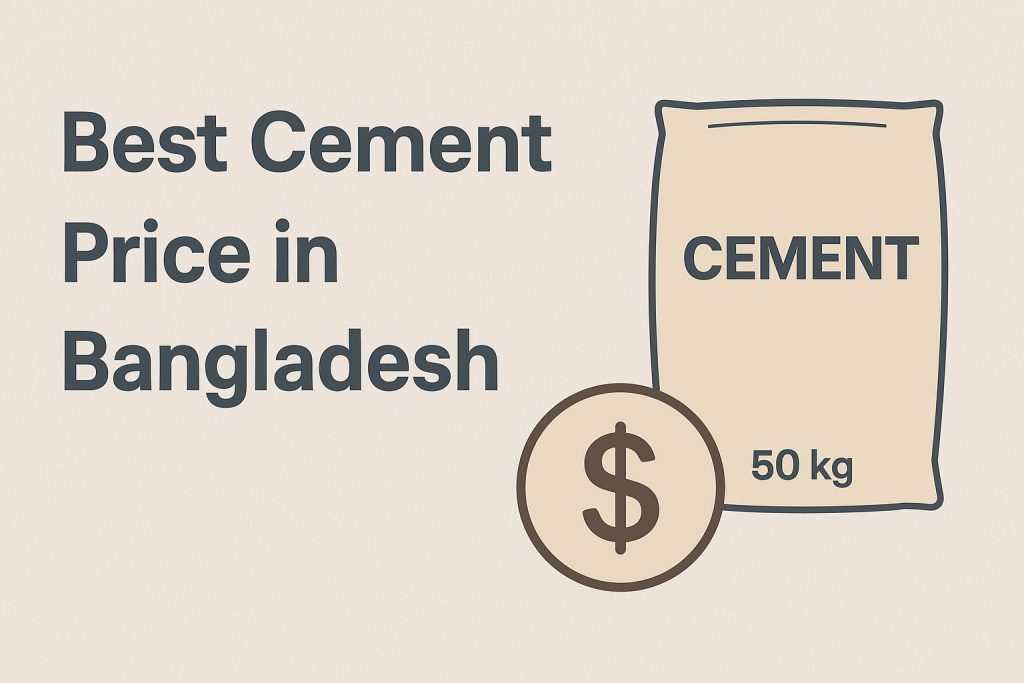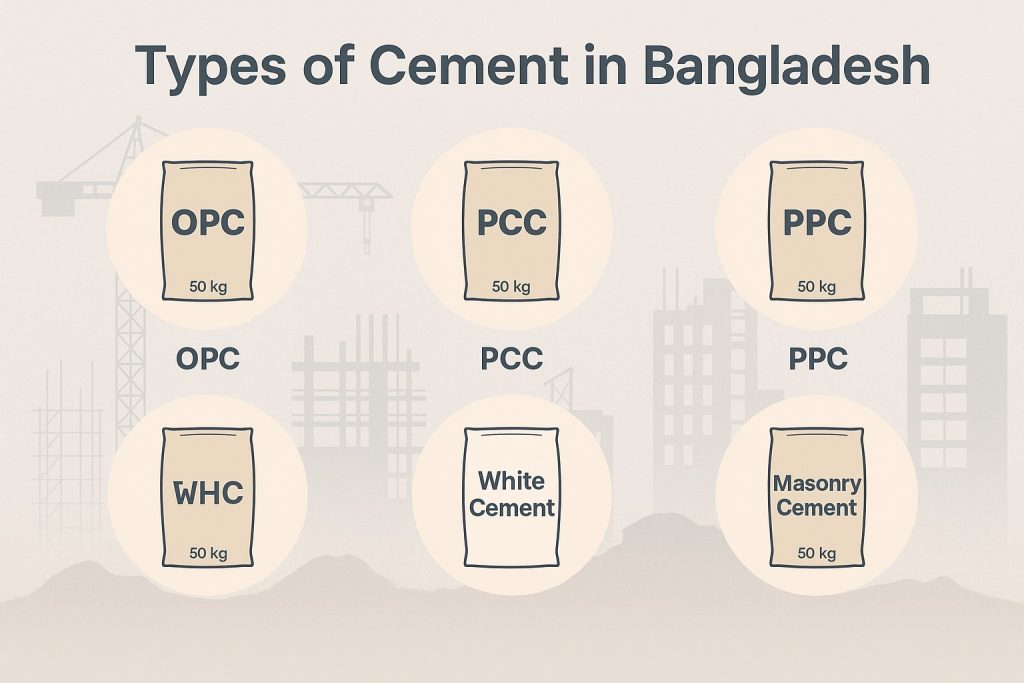Cement is the backbone of Bangladesh’s rapid urbanization and infrastructure growth. From towering skyscrapers in Dhaka to rural housing in village towns, cement plays a vital role in shaping the nation’s development. As construction continues to boom, one of the most discussed topics among builders, engineers, and homeowners is the cement price in Bangladesh — a factor that directly influences investment decisions and long-term project feasibility. Understanding market trends, pricing factors, and regional variations has become essential for entrepreneurs exploring new business ideas in Bangladesh, especially those entering the construction, real estate, or building materials sectors.

Understanding price trends, influencing factors, and brand variations helps consumers and professionals make smart buying decisions. This article explores current market rates, brand comparisons, the forces driving price changes, and tips for getting the best value — all in one comprehensive business guide.
Current Cement Price in Bangladesh (2025 Update)
As of October 2025, the average retail price of a 50 kg cement bag in Bangladesh ranges between ৳470 – ৳520, depending on the brand, type, and location. Premium products or specialized variants may cost up to ৳650 – ৳700 per bag.
Here’s an approximate overview of leading brands and their market ranges:
| Brand Name | Type | Average Price (৳/50 kg bag) | Category |
|---|---|---|---|
| Shah Cement | Portland Composite (PCC) | 480 – 500 | Standard |
| Seven Rings Cement | Ordinary Portland (OPC) | 470 – 490 | Standard |
| Holcim Cement | Premium Water Protect / PCC | 620 – 690 | Premium |
| Supercrete | OPC | 500 – 520 | Standard |
| Akij Cement | PCC | 490 – 510 | Standard |
| Bashundhara Cement | PCC | 480 – 500 | Standard |
| Scan Cement | OPC | 500 – 520 | Standard |
| Fresh Cement | PCC | 470 – 490 | Budget |
| Crown Cement | OPC | 490 – 510 | Standard |
| Premier Cement | PCC | 480 – 500 | Standard |
Prices vary slightly across Dhaka, Chattogram, Sylhet, Rajshahi, and other districts due to transportation and dealer margins.
Types of Cement Available in Bangladesh
To fully understand the pricing landscape, it’s important to know the types of cement used in the market. Each type serves a unique structural or environmental purpose, which directly influences its cost.

1. Ordinary Portland Cement (OPC)
- High strength and fast setting.
- Commonly used for reinforced concrete structures, roads, and bridges.
- Slightly costlier due to higher clinker content.
2. Portland Composite Cement (PCC)
- A blend of clinker with fly ash, slag, or limestone.
- More eco-friendly and cost-effective.
- Offers better durability for long-term structures.
3. White Cement
- Used for decorative finishing, tiles, and facades.
- Price ranges between ৳950 – ৳1,050 per bag.
4. Sulfate-Resisting Cement
- Designed for coastal or saline-soil projects.
- Higher cost but essential for long-term protection.
5. Rapid Hardening Cement
- Sets faster and used for emergency or precast structures.
- Carries a premium price due to additives and energy use.
Major Factors Influencing Cement Price in Bangladesh
Cement prices in Bangladesh are shaped by a network of economic, industrial, and logistical variables. The country relies heavily on imported clinker, gypsum, and fly ash—so global raw material prices and exchange rate fluctuations directly impact local costs. Energy expenses, especially electricity and fuel for kilns and transport, contribute significantly since cement production is energy-intensive. Government taxation, VAT adjustments, and import duties further affect manufacturing margins. Seasonal demand also plays a role—prices typically rise during peak construction months and stabilize during the monsoon. Transportation costs, brand reputation, and inflation add additional pressure, making the cement price in Bangladesh sensitive to both global and domestic conditions. Manufacturers must balance operational efficiency, raw material sourcing, and logistics to remain competitive while meeting quality standards that drive consumer trust.
1. Raw Material Costs
- Bangladesh imports a significant amount of clinker, gypsum, and slag from countries like Indonesia, Vietnam, and China.
- When international prices of clinker rise, local cement price increases proportionally.
2. Fuel and Power Prices
- Energy accounts for over 35% of cement production cost.
- Rising gas, coal, and electricity tariffs have a direct effect on the retail price per bag.
3. Transportation and Logistics
- Cement is heavy and costly to transport.
- Poor road infrastructure, higher diesel prices, or port delays can add 2 – 5 % to the final retail cost.
4. Government Taxes and Import Duties
- The national budget 2025–26 introduced new value-based duties on clinker, raising production cost by an estimated ৳10 – ৳12 per bag.
- VAT and corporate taxes also influence retail pricing.
5. Currency Fluctuation
- As the Bangladeshi Taka depreciates, import-based raw materials become more expensive.
- Exchange rate volatility adds uncertainty to future cement pricing.
6. Market Demand and Seasonality
- Demand surges in the dry season (November – April) when most construction takes place.
- During monsoon, demand slows, and suppliers may offer discounts.
7. Brand Reputation and Quality Assurance
- Top brands with ISO and BSTI certifications often charge a premium for reliability, strength, and durability.
Regional Price Differences Across Bangladesh
Cement prices vary across Bangladesh due to differences in geography, infrastructure, and distribution networks. Urban centers like Dhaka, Chattogram, and Khulna enjoy relatively stable pricing because of multiple suppliers, proximity to factories, and efficient logistics. In contrast, rural or remote regions often experience higher prices—sometimes ৳20–৳50 more per bag—due to transportation costs, limited dealer competition, and storage challenges. River or port-connected zones usually have cost advantages because bulk transport is cheaper than road freight. Additionally, regional demand patterns affect retail pricing: industrial areas with large projects may secure bulk discounts, while small local markets face retail markups. Thus, the cement price in Bangladesh is not uniform; it reflects logistical realities, accessibility, and local purchasing capacity.
Urban Centers (Dhaka, Chattogram, Khulna)
- Lower prices due to higher competition and easier logistics.
- Bulk buyers like developers and contractors often get additional discounts.
Rural and Remote Areas
- Higher transportation cost (৳20–৳50 per bag).
- Fewer distributors result in less price competition.
Industrial Zones
- In areas close to factories (like Narayanganj or Mongla), prices are comparatively stable.
For example, a 50 kg bag of Shah Cement might cost ৳490 in Dhaka but ৳530 – ৳550 in remote districts due to delivery costs.
Cement Industry Overview in Bangladesh
Bangladesh’s cement sector is one of the fastest-growing in South Asia, supported by massive infrastructure projects such as Padma Bridge, metro rail, and Dhaka expressways.
- Annual production capacity: Over 70 million tons
- Utilization rate: ~60 – 65 %
- Number of active factories: More than 40 major manufacturers
- Employment: Over 15 lakh people directly and indirectly
The leading domestic producers include Shah Cement, Crown, Bashundhara, Akij, and Premier Cement, while multinational companies like Holcim and Lafarge maintain a premium segment.
Cement Price Trend (2022 – 2025)
| Year | Average Price per Bag (৳) | Price Movement |
|---|---|---|
| 2022 | 430 – 450 | Stable |
| 2023 | 460 – 480 | Moderate rise due to global inflation |
| 2024 | 480 – 510 | Increased import & fuel cost |
| 2025 | 490 – 520 | Influenced by new tariff and exchange rate |
Trend Summary:
The last three years have seen a steady 5 – 8 % annual increase in cement prices due to rising raw-material imports, fuel costs, and regulatory changes. Experts predict that unless global energy prices fall or local clinker production expands, prices will continue to rise slightly through 2026.
Market Forecast for 2026
- Expected price range: ৳500 – ৳550 per bag for standard cement, it’s definitely depending on the construction growth rate and raw materials import cost.
- Large infrastructure projects like Dhaka–Chattogram Expressway will sustain high demand.
- Manufacturers may invest more in energy-efficient kilns and local clinker plants to control costs.
- Eco-friendly cement (PPC, slag-based) will grow due to environmental regulations.
Overall, the market outlook remains positive but cost-sensitive, meaning steady growth with moderate inflationary pressure.
How to Choose the Right Cement for Your Project
Selecting the correct cement is not only about price — it’s about performance, strength, and durability.
1. For House Construction
- Choose PCC or OPC 43-grade cement from reputed brands.
- Ideal for slabs, beams, and columns.
2. For Large Structures
- OPC 53-grade or Supercrete Cement ensures better compressive strength.
3. For Marine or Coastal Projects
- Sulfate-resistant cement protects against corrosion and salt damage.
4. For Finishing or Decorative Work
- White cement gives a clean, aesthetic appearance.
Always check the manufacturing date and batch number before purchase to avoid using expired cement.
Tips to Buy Cement at the Best Price
- Compare multiple dealers — Collect quotations from different local suppliers.
- Buy in bulk — Orders above 100 bags usually attract 2–3 % discounts.
- Check seasonal offers — Off-season discounts or brand promotions reduce cost.
- Avoid middlemen — Purchase directly from company dealers when possible.
- Calculate transport cost — Sometimes buying cheaper cement from a distant area adds hidden delivery expenses.
- Inspect packaging — Ensure bags are dry, sealed, and free from moisture damage.
- Monitor price updates — Follow monthly price indexes or dealer circulars to stay informed.
Why Cement Prices Fluctuate So Often
Cement prices are inherently dynamic because the industry is exposed to global supply chain pressures. Bangladesh imports over 80 % of its clinker and other additives. When shipping costs or fuel prices spike internationally, it directly reflects on the domestic market.
Furthermore, political decisions such as budget revisions, tax reforms, and energy subsidies play a major role in short-term fluctuations.
Thus, while consumers may see small monthly changes, the overall trajectory in recent years has been slow and steady upward movement rather than volatility.
Environmental and Sustainability Factors
Bangladesh is increasingly adopting green cement practices to lower CO₂ emissions from clinker production. Composite and pozzolanic cements consume less energy and release fewer greenhouse gases.
Manufacturers are now:
- Investing in waste heat recovery systems.
- Using fly ash and slag from other industries.
- Shifting toward energy-efficient grinding units.
These sustainability initiatives may slightly raise the initial cost, but they ensure long-term environmental and economic benefits for the construction sector.
Future of the Cement Industry in Bangladesh
With the government’s focus on “Smart Bangladesh 2041,” the cement sector will remain a pillar of industrial expansion. Ongoing mega projects, urban housing demands, and the rise of eco-construction will continue driving growth.
Key future trends include:
- Automation & AI-based quality control in cement plants.
- Digital dealer networks for real-time price updates.
- Localized clinker production to reduce dependency on imports.
- Carbon-neutral cement technologies aligned with global climate goals.
Overall, the future looks strong for both investors and consumers, though strategic planning will be vital for cost optimization.
Certification Standards for Cement in Bangladesh
Cement certification ensures that every bag sold in Bangladesh meets national quality, safety, and performance standards. The Bangladesh Standards and Testing Institution (BSTI) is the primary authority responsible for regulating and certifying cement quality across the country. All manufacturers, whether local or multinational, must obtain BSTI approval before marketing their products.
Certified cement ensures proper composition, strength, and durability suitable for Bangladesh’s climate and construction requirements.
Key Certification Standards:
- BSTI Marking: Mandatory quality assurance mark verifying compliance with BDS EN 197-1:2003 standards.
- ISO Certification: Many top brands maintain ISO 9001 and ISO 14001 for quality and environmental management.
- Lab Testing Requirements: Includes fineness, setting time, compressive strength, and chemical composition analysis.
- Clinker Quality Inspection: Ensures imported raw materials meet global standards.
Adherence to these certification standards builds trust, enhances structural safety, and supports sustainable construction in Bangladesh
Final Thoughts
The cement price in Bangladesh reflects a complex balance of global supply, local demand, and policy frameworks. While current prices hover between ৳470 to ৳520 per 50 kg bag, premium brands or special variants can cost more.
For anyone planning to build a home, factory, or infrastructure project, staying informed about the market trend ensures better budgeting and long-term savings.
Always prioritize quality over short-term savings — reliable cement ensures durability, safety, and value for decades to come.


